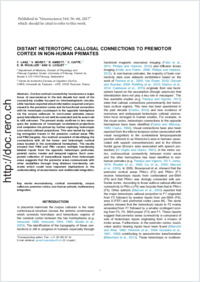Distant heterotopic callosal connections to premotor cortex in non-human primates
- Lanz, Florian Department of Medicine, Domain of Physiology and Fribourg Cognition Center, University of Fribourg, Switzerland
- Moret, Véronique Department of Medicine, Domain of Physiology and Fribourg Cognition Center, University of Fribourg, Switzerland
- Ambett, R. Department of Medicine, Domain of Physiology and Fribourg Cognition Center, University of Fribourg, Switzerland
- Cappe, Céline Centre de recherche Cerveau et Cognition (CerCo), CNRS, Université de Toulouse – UPS, France
- Rouiller, Eric M. Department of Medicine, Domain of Physiology and Fribourg Cognition Center, University of Fribourg, Switzerland
- Loquet, Gérard Department of Medicine, Domain of Physiology and Fribourg Cognition Center, University of Fribourg, Switzerland
-
06.03.2017
Published in:
- Neuroscience. - 2017, vol. 344, p. 56–66
English
Cortico-cortical connectivity has become a major focus of neuroscience in the last decade but most of the connectivity studies focused on intrahemispheric circuits. Little has been reported about information acquired and processed in the premotor cortex and its functional connection with its homotopic counterpart in the opposite hemisphere via the corpus callosum. In non-human primates (macaques) lateralization is not well documented and its exact role is still unknown. The present study confirms in two macaques the existence of homotopic contralateral projections and completes the picture by further exploring heterotopic (non-motor) callosal projections. This was tested by injecting retrograde tracers in the premotor cortical areas PMv and PMd (targets). Our method consisted of identifying the connections with all the homo- and heterotopic cortical areas located in the contralateral hemisphere. The results showed that PMd and PMv receive multiple low-density labeled inputs from the opposite heterotopic prefrontal, parietal, motor, insular and temporal regions. Such unexpected collection of transcallosal inputs from heterotopic areas suggests that the premotor areas communicate with other modalities through long distance low-density networks which could have important implications in the understanding of sensorimotor and multimodal integration.
- Faculty
- Faculté des sciences et de médecine
- Department
- Département de Médecine
- Language
-
- English
- Classification
- Biological sciences
- License
-
License undefined
- Identifiers
-
- RERO DOC 288709
- DOI 10.1016/j.neuroscience.2016.12.035
- Persistent URL
- https://folia.unifr.ch/unifr/documents/305534
Statistics
Document views: 106
File downloads:
- pdf: 176
